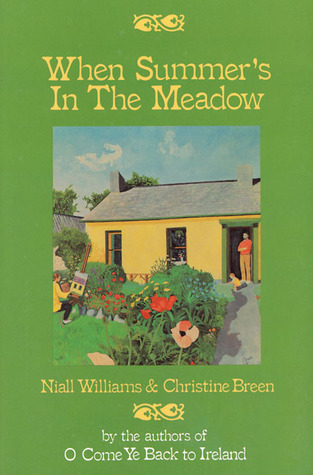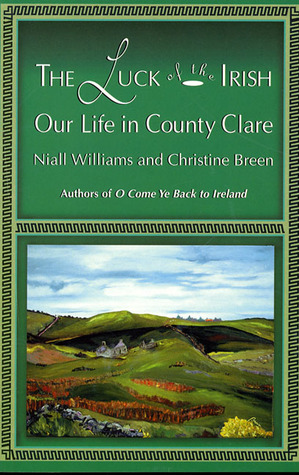

When Summer’s in the Meadow
-and-
The Luck of the Irish: Our Life in County Clare
by Niall Williams and Christine Breen
Soho Press, 1989 and 1995
Reviewed by Barbara Free, M.A.
Both authors (they are a married couple) are Irish. He was born in Dublin and grew up there, later moving to New York City, where he worked for a publishing firm. She grew up in the U.S., but her grandparents were from Ireland, and it was to her grandfather’s cottage and small farm in County Clare that they moved, with the intention of making their living farming, and raising a family.
When Summer’s in the Meadow opens 18 months after the authors’ arrival in Ireland; they are still struggling to learn how to farm, trying to plant crops, and care for their “herd” of four cows. Having used up practically all of their savings, the fate of their dream of a life together in Ireland now depends on their being able to get the manuscript of their first book, O Come Ye Back to Ireland—the story of the couple’s “First Year in County Clare,” when it rained all summer—accepted by a publisher in New York.
Christine plants flowers and vegetables, does some writing, and paints. They have had to deal with their grief over being unable to have biological children and have decided to adopt. They have contacted the local adoption agency, St. Catherine’s Adoption Society in Ennis, only to learn that the waiting list was closed. Almost a year later, they could finally get on the waiting list.
This early part of Summer discusses both their feelings as they go through this slow process, their hopes and fears. They begin to believe that “there would be a little baby out there somewhere waiting for us.” Of course, the child is not born yet, so not “waiting.” If a child was already born, one hopes s/he would not be waiting, but would be with them, or with whoever adopted him/her.
They continue to farm and things get better. They have to fill out forms to prove they are employed and able to support a child, which is still a bit iffy; but just then, a New York publisher contacts them about the manuscript and gives them a contract and an advance. As the book progresses to this point, the reader is able to picture them in Ireland, and their story, particularly Niall’s, is written in such a way one can almost hear his Irish accent and watch it rain.
By that time, one could adopt children in Ireland only if one were an Irish citizen, which Niall is but Christine is not yet. When they ask how old the baby they hope to adopt might be, their adoption counselor said, “We try to place babies within the first six months of the baby’s life, but you never know.” Reading this in the U.S., in 2020, this reader was horrified, especially when the woman continued, “They will have been cared for by a foster mother.” Then she explains that, after they actually get the child, there is a period of six months to more than a year, when they have the child, but the adoption is not final. “It’s a trial period.” I kept thinking about this child, wondering how they could be so calm and unhurried about the legal procedure, and how the adoptive parents would be able to bond with this child, knowing the birth mother could still change her mind, or, as the woman said, “During that time you can give the baby back.” Sounds like a furniture sale, or a rent-to-own house. Times had certainly changed since infants were snatched from their birth mothers at so-called Irish laundries and whisked off to the U.S. by rich American adoptive parents. By coincidence, the authors live not far from Rosecrea, where Philomena Lee had lived when her child was taken from her. The adoption laws and customs have improved since then, but still, it was a revolutionary idea that the birth mother would want to meet the adoptive parents, but only if they wanted to meet her, and then only once and first names only!
When, at long last, they get the baby, she is ten weeks old. They have met the birth mother and really liked her, and even discovered that the birth mother had given the baby the same name they had chosen: Deirdre. Yet it never occurred to any of them that they could have any further contact. Christine finds that she knows nothing about caring for a baby, in spite of have grown up the oldest of six children, and had presumably babysat her siblings. Fortunately for them, this baby turned out to be exceptionally easy about everything. There are neighbors and friends with several children each who help her confidence, including one other adoptive mother.
The rest of the book proceeds with the authors’ musings about parenthood, their experiences with the ups and downs of farming and writing, remodeling the cottage to add an upstairs bedroom, but finding the stairs too narrow to get a full bed up there, and enjoying their life in Ireland.
The first book was so enjoyable that I decided to purchase another. In The Luck of the Irish, the authors followed the same format as in the first, where they alternate writing, although he does about two-thirds of it. They are so earnest and so naive in many ways, about parenting as well as farming, but they keep trying and learning. He tries to grow potatoes under black plastic, only to discover that slugs ate them all! She ponders the meaning of “mother,” and says sometimes she feels she’s only “playing” mother, which may be not uncommon for an adoptive mother at first, and not unheard of for a biological mother raising her own child. In her view, giving birth to a child and having her from that moment on means there is a bond between them that an adoptive mother and child have to work longer and harder to achieve. Furthermore, Niall and Chris had left the baby, Deirdre, for two and a half weeks while they went to the U.S. and could not take her, as she was not yet legally adopted. They get easily caught up in the idea that they were “meant” to have her, though, with no thought about whether the birth mother was “meant” to lose her. When the adoption was final (at the end of the first book), the Adoption Board asks them if the child (11 months old) knows what’s happening, which seems really silly, to expect an infant to understand legal procedures.
Niall is now teaching part-time in a secondary school; a lot of people from the States have come to visit from time to time, having read their first book. The little girl is in preschool of some sort, they’ve given up on raising cows, and they’ve been approved to adopt a second child. Just as the little girl turns three, they are called to come in and meet a birth mother who has given birth to a baby boy. She is adamant that her child must be raised in a two-parent family, Ireland being Ireland.
Niall states, “When we were introduced we had not used our surnames. We met concealed behind a thin veil of anonymity. But, knowing that my play was about to be staged and that my picture would be published in the theater sections of Irish newspapers, I asked her if she felt enough at peace with her decisions that, though she might learn where the child lived, she could leave him to his new life.”
As a birth mother, this was the most difficult sentence in the book for me to read. They still seemed to be afraid she would “snatch the child back.” This seems to be a primal fear of adoptive parents, and of society, which keeps promoting this idea of unbalanced birth mothers who will kidnap their children. At this point they tell the daughter of her own adoption through the same agency. It’s not clear if they’ve never told her before. She is now four years old. As it turned out, the play was a flop—the Irish audiences did not really get the humor.
The rest of The Luck of the Irish is not quite as focused on the adopted children (they have a hard time not focusing on the “adopted” aspect of being parents), and more on his writing, her gardening and painting, and their lives in the community. lt is another very rainy summer. He writes that, “Earlier in the week I had read in the Irish Times that the writing that mythologizes the experience of the west of Ireland all comes from Dublin-based intellectuals; rural romantic places do not in fact exist. I wonder ... we need whatever romance we can conjure.” Christine worries that the children are too “separate” in some ways from other children because they are adopted, plus she, their mother, still has an American accent. Their mare has at last had a foal, the spring seems peaceful and he says, “Perhaps this will be the long awaited long warm summer.”
One wishes they had written a book years later when these children were grown and they had all learned more about adoption, family relationships, and perhaps about birth parents. Although Niall Williams has written many more books and plays, apparently there have been no more about his family.
Both of these books are enjoyable, easy reading, and thoughtful, aside from the authors’ apparent continued lack of insight into a birth mother’s point of view, or an adopted person’s point of view. That’s why we’d love to see how their lives are in 2020! Finally, although Niall Williams grew up in Ireland, and Christine is also Irish, neither of them grew up in rural west Ireland. Yet their children are from Ireland, growing up as rural Irish children. In that sense, the parents are the adoptees!
Excerpted from the June 2020 edition of the Operation Identity Newsletter
© 2020 Operation Identity